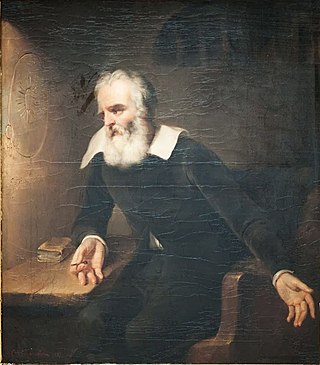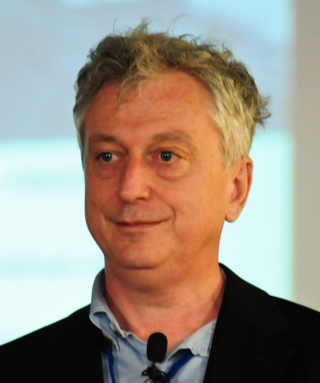This article relies largely or entirely on a single source .(April 2024) |

Arcetri is a location in Florence, Italy, positioned among the hills south of the city centre.
This article relies largely or entirely on a single source .(April 2024) |

Arcetri is a location in Florence, Italy, positioned among the hills south of the city centre.
A number of historic buildings are situated there, including the house of the famous scientist Galileo Galilei (called Villa Il Gioiello ), [1] the Convent of San Matteo and the Torre del Gallo. The Arcetri Observatory is also located there. The church of San Leonardo in Arcetri is the main church of the area.
Galileo Galilei died there on 8 January 1642.
The following is a longer list of landmarks in the Arcetri area, with their Italian names:

Pisa is a city and comune in Tuscany, central Italy, straddling the Arno just before it empties into the Ligurian Sea. It is the capital city of the Province of Pisa. Although Pisa is known worldwide for its leaning tower, the city contains more than twenty other historic churches, several medieval palaces, and bridges across the Arno. Much of the city's architecture was financed from its history as one of the Italian maritime republics.

Livorno is a port city on the Ligurian Sea on the western coast of the Tuscany region, Italy. It is the capital of the Province of Livorno, having a population of 158,493 residents in December 2017. It is traditionally known in English as Leghorn.

The Forte di Belvedere or Fortezza di Santa Maria in San Giorgio del Belvedere is a fortification in Florence, Italy.

Vincenzo Viviani was an Italian mathematician and scientist. He was a pupil of Torricelli and a disciple of Galileo.

Sister Maria Celeste was an Italian nun. She was the daughter of the scientist Galileo Galilei and Marina Gamba.

The Arcetri Observatory is an astrophysical observatory located in the hilly area of Arcetri on the outskirts of Florence, Italy. It is located close to Villa Il Gioiello, the residence of Galileo Galilei from 1631 to 1642. Observatory staff carry out theoretical and observational astronomy as well as designing and constructing astronomical instrumentation. The observatory has been heavily involved with the following instrumentation projects:

"And yet it moves" or "Although it does move" is a phrase attributed to the Italian mathematician, physicist and philosopher Galileo Galilei (1564–1642) in 1633 after being forced to recant his claims that the Earth moves around the Sun, rather than the converse. In this context, the implication of the phrase is: despite his recantation, the Inquisition’s proclamations to the contrary, or any other conviction or doctrine of men, the Earth does, in fact, move.

Alessandro Maria Gaetano Galilei was an Italian mathematician, architect and theorist, a member of the same patrician family as Galileo.

Museo Galileo is located in Florence, Italy, in Piazza dei Giudici, along the River Arno and close to the Uffizi Gallery. The museum, dedicated to astronomer and scientist Galileo Galilei, is housed in Palazzo Castellani, an 11th-century building which was then known as the Castello d'Altafronte.

Margherita Hack was an Italian astrophysicist and scientific disseminator. The asteroid 8558 Hack, discovered in 1995, was named in her honour.

Piazza della Minerva is a piazza in Rome, Italy, near the Pantheon. Its name derives from the existence of a temple built on the site by Pompey dedicated to Minerva Calcidica, whose statue is now in the Vatican Museums.

Villa il Gioiello is a villa in Florence, central Italy, famous for being one of the residences of Galileo Galilei, which he lived in from 1631 until his death in 1642. It is also known as Villa Galileo.

The Torre del Gallo is a historical building located in Florence, Italy, located at Pian de' Giullari, in the hills of Arcetri, on top of a ridge overlooking the city where there is a magnificent panorama.

Vito D'Anna was an Italian painter, considered the most prominent painter of Palermitan rococo and one of the most important artists of Sicily.

La Storta is the 51st zona of the Italian capital city, Rome. It is identified by the initials Z. LI and falls within the boundaries of Municipio XV.

Boncompagni Ludovisi Decorative Arts Museum, Rome, is the Decorative Arts Museum of the National Gallery of Modern Art of Rome. The Museum is located at Via Boncompagni, 18, near the elegant and historical Via Veneto.
Tommaso Perelli (1704–1783) was an Italian astronomer. Born into a noble family of Arezzo, Perelli was encouraged by his father to study law at the University of Pisa, but Guido Grandi (1671–1742), an abbot who was teaching mathematics there, steered him toward science. When his father died, Perelli abandoned the study of law for good. He decided to get a degree in physics and medicine. He studied astronomy and medicine at the University of Bologna, and Greek literature at the University of Padua. He was then appointed by the Tuscan government to the chair in astronomy at the University of Pisa, where he became a noted astronomer and hydraulics expert. He was the first to identify the hill of Arcetri, near Galileo's (1564–1642) last home, Villa Il Gioiello, as ideal location for astronomical observations.

The Jewel of Vicenza was a silver model of the city of Vicenza made as an ex-voto in the 16th century and attributed to the architect Andrea Palladio. The Jewel was stolen by the Napoleonic army during the Italian Campaign in the French Revolutionary Wars and subsequently destroyed. A copy was created between 2012 and 2013.
Zanobi Canovai was an Italian painter and draughtsman

Alessandro De Angelis is an Italian and Argentine physicist and astrophysicist. A Professor of Experimental Physics at the University of Padova and Professor Catedratico of Astroparticle Physics at IST Lisboa, he is mostly known for his role in the proposal, construction and data analysis of new telescopes for gamma-ray astrophysics. He is a member of Istituto nazionale di fisica nucleare (INFN), Istituto nazionale di astrofisica (INAF), Italian Physical Society (SIF), International Astronomical Union (IAU), Gruppo2003.